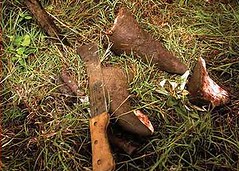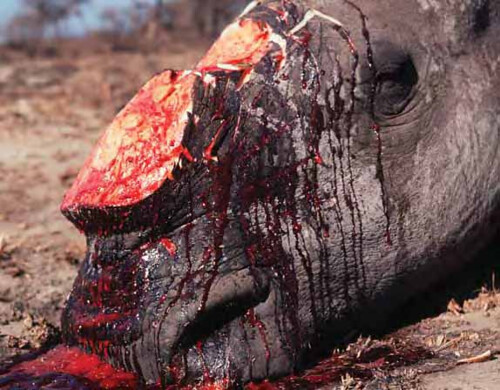 南非官方11日公布2012年犀牛盜獵死亡數據,相較2005年14隻犀牛遭盜獵死亡,2012年有668隻犀牛因盜獵而喪失生命。
南非官方11日公布2012年犀牛盜獵死亡數據,相較2005年14隻犀牛遭盜獵死亡,2012年有668隻犀牛因盜獵而喪失生命。
保育學家認為有貪瀆狩獵業者勾結外部的犯罪集團獵殺犀牛,這些集團都有良好的組織、資金雄厚,且具高機動性。
相較於2011年南非盜獵者獵殺了448隻犀牛,2012年幾乎增加了一倍,共有668隻犀牛遭到獵殺。且2013年才剛開始,已有5隻犀牛遭盜獵者獵殺。
由世界自然基金會(WWF)及瀕危物種紅皮書發佈單位「世界自然保育聯盟」(IUCN)組成的策略聯盟「國際野生物貿易研究委員會」(TRAFFIC),日前發佈2012年報,指犀牛盜獵現象是「南非前所未有的保護危機」,儘管該國先前曾有良好的犀牛保育事蹟。
根據TRAFFIC最新報告《南非‧越南犀牛角交易連結》(The South Africa – Viet Nam Rhino Horn Trade Nexus),跡象顯示近期獵殺犀牛的方式達到令人擔憂的全新層次。這份報告的共同作者是TRAFFIC的Tom Milliken及WWF南非非會的計畫共同主持人Jo Shaw博士。
報告中描述:「過去犀牛通常是被AK-47等槍枝射殺;近來越來越多的犀牛是被專業狩獵者常用的大口徑武器單次擊發射殺身亡、還有少數例子是用藥物麻醉犀牛後將犀牛角取下;某些犯罪現場甚至有使用直昇機的跡象,設備之精良,顯示犀牛盜獵正出現全新樣貌。」
報告指出,「情勢發展凸顯了當前危機:惡劣的獵場經營者、職業獵人、狩獵戰利品經營者、直昇機飛行員和野生動物獸醫,都加入盜獵者行列。」「即便一些南非私人犀牛擁有者及野生動物行業人員持續承諾保護犀牛、支持犀牛保育,這獨特而毀滅性的發展,仍嚴重損及南非在維護犀牛平衡上扮演關鍵角色的形象。」
最新政府統計資料顯示,2012年犀牛盜獵事件多數發生在南非旅遊熱點──克魯格國家公園,達到425隻,相較於2011年的252起盜獵案件,大幅攀升。
 TRAFFIC報告中的位作者寫到:「南非中央或省級官員串謀或放縱違法交易的情況,也都已紀錄下來。2012年克魯格國家公園4名公家巡守員因獵殺犀牛遭到逮捕,另林波波省的亞瑟斯通(Atherstone)自然保護區一名儲備經理在因涉及5隻犀牛死亡事件,於羈押時自殺。省管理單位一直對『偽狩獵』睜一隻眼閉一隻眼,尤其是西北省及林波波省,並允許違反受威脅及保護物種規章的犀牛獵殺行為發生。」
TRAFFIC報告中的位作者寫到:「南非中央或省級官員串謀或放縱違法交易的情況,也都已紀錄下來。2012年克魯格國家公園4名公家巡守員因獵殺犀牛遭到逮捕,另林波波省的亞瑟斯通(Atherstone)自然保護區一名儲備經理在因涉及5隻犀牛死亡事件,於羈押時自殺。省管理單位一直對『偽狩獵』睜一隻眼閉一隻眼,尤其是西北省及林波波省,並允許違反受威脅及保護物種規章的犀牛獵殺行為發生。」
報告描述:「令人震驚的,違法交易的犀牛角是從活犀牛身上殘忍的直接取下。從1990到2005年16年間,每年平均因盜獵死亡的犀牛是14隻;2008年這個數字成長到83隻,2009年則來到122隻。到了2010年,整年的盜獵數戲劇化的攀升近3倍,共有333隻犀牛被獵殺。2011年數字再次攀升到破紀錄的448隻。」
2012年,南非有668隻犀牛被獵殺。同年,南非遭逮捕的盜獵嫌犯也增加了,267個人面臨犀牛相關罪案的指控。11月,一位泰籍男子共謀走私犀牛角至亞洲獲判刑40年。
在許多亞洲國家,尤其是越南,犀牛角被認為有醫療效果、且為地位的象徵。越南原生的犀牛近年已被逼至滅絕。
犀牛角是由構成頭髮和指甲相同的角蛋白所組成,沒有任何證據顯示具有醫學價值,犀牛角的商業價值全由有組織、有資金及高機動性的犯罪集團在推波助瀾。
TRAFFIC 推廣主任Sabri Zain表示,「越南必需削減該國對犀牛角的需求,他們的需求助長了南非的犀牛盜獵。」
 TRAFFIC報告也指出,「越南似乎是全球唯一普遍認為犀牛角可以壯陽的國家。」磨成粉的犀牛角也普遍用於飲酒過量後的解毒,「可能是目前市面上最常見的使用方式。」
TRAFFIC報告也指出,「越南似乎是全球唯一普遍認為犀牛角可以壯陽的國家。」磨成粉的犀牛角也普遍用於飲酒過量後的解毒,「可能是目前市面上最常見的使用方式。」
Zain陳述,「犀牛遭非法屠殺,切除牠們的角後留下牠們流血至死,一切只為了輕率的使用犀牛角來治療宿醉。」
打擊盜獵集團 需跨國合作
12月,越南和南非簽署協議,目的在於提供法律支援及打擊非法野生動物貿易,包括犀牛角的非法交易在內。
該協議提供兩國資訊共享及共同努力的立基點,來打擊藏匿於走私網路後的犯罪集團。
Jo Shaw博士指出,「我們樂見南非及越南簽署關於生物多樣性保育的備忘錄,但我們現在需要的是,落實聯合犀牛行動方案,扣押更多犀牛角。此外也需要與非法運送犀牛角路線上的國家密切合作,特別是莫三比克。」
本月稍早,兩名越南籍男子因走私犀牛角分別在泰國及越南被羈押,據信這些犀牛角是由莫三比克出口。
莫三比克和越南都因缺乏有效執法力來保護犀牛,在WWF野生動物罪案紀錄(WWF's Wildlife Crime Scorecard)中獲評為不及格。
TRAFFIC報告中也解釋,現今所有白犀牛南部亞種,都源於1895年南非Hluhluwe-iMfolozi狩獵保護區的20-50隻個體。南非目前有18800隻白犀牛,佔白犀牛現存族群量的95%。
Shaw和Milliken在報告中表示,「透過那塔爾省公園管理委員會『犀牛行動』,南方白犀牛保育成果斐然;『犀牛行動』建立野生動物運輸及其他動要的經營管理策略,目前仍是最成功的保育案例之一。」
報告中讚譽南非的私人機構對白犀牛族群量增長的貢獻。粗估從2010年起,南非約有25%的白犀牛為私人機構所擁有。
目前在IUCN紅皮書中,南方白犀牛分類在近危(Near Threatened)項目,即便依賴保育,其亞種不再被認為是受威脅或瀕危物種。
報告描述,非洲的另一種犀牛──黑犀牛,幾乎被消滅殆盡。在第一次災難性的犀牛盜獵危機前,1960年估計有10萬隻黑犀牛,到了1995年止剩下2410隻。從那之後到2010年,族群量成長了幾乎一倍,約有4880隻,但黑犀牛仍名列IUCN紅皮書中的極度瀕危物種。
南非黑犀牛的數量自1980年代以來有穩定的成長,目前約有1915隻,約是所有野生黑犀牛的40%。再一次,私人機構在黑犀牛保育中扮演關鍵角色,約佔南非現存族群量的22%。
然而,TRAFFIC報告也提醒,「南非一個世紀多來保持的最高紀錄,目前受到盜獵的威脅。」他們建議南非政府,要確保因犀牛盜獵受逮捕的人都或受到起訴及懲罰。
Record rhino poaching death statistics released by the South African government Friday reveal a grim picture – 668 rhinos lost their lives to poachers in 2012 – up from 14 rhinos killed by poachers in 2005.
Conservation scientists report that corrupt game industry insiders are now poaching rhinos alongside other criminal groups – all well organized, well financed and highly mobile.
The 668 rhinos killed across South Africa in 2012 is an increase of nearly 50 percent from the 448 rhinos poachers killed in 2011. Five more rhinos were killed by poachers just since the beginning of this year.
A 2012 report by the international wildlife trade monitoring network TRAFFIC, calls these rhino killings “an unprecedented conservation crisis for South Africa,” which until recently has had a stellar rhino conservation record.
TRAFFIC is a strategic alliance of the global conservation group WWF and the International Union for the Conservation of Nature, IUCN, which maintains the IUCN Red List of Threatened Species.
The methods used in the most recent rhino killings show a new, very worrying dimension, says the TRAFFIC report, “The South Africa – Viet Nam Rhino Horn Trade Nexus,” co-authored by Dr. Jo Shaw, rhino co-ordinator with the South Africa chapter of WWF, and Tom Milliken of TRAFFIC,
“Typically, rhinos are killed by shooting with guns, usually AK-47 assault rifles. More recently, however, a growing number of rhinos have been killed by a single shot from a high-calibre weapon characteristically only used by wildlife industry professionals or, less frequently, have been darted with immobilization drugs and had their horns removed,” Shaw and Milliken report.
“The use of such equipment, and other evidence that has even suggested the presence of helicopters at crime scenes, represents a completely “new face” in terms of rhino poaching,” they write.
“Such developments underscore the emergence of corrupt game industry insiders into rhino poaching. Rogue game ranch owners, professional hunters, game capture operators, pilots and wildlife veterinarians have all entered the rhino poaching crisis and become active players,” write Shaw and Milliken.
“This is a unique and devastating development in South Africa, severely tarnishing the image of a key stakeholder in the rhino equation even if the majority of private rhino owners and wildlife industry personnel remain committed to protecting rhinos and supporting rhino conservation.”
A majority of the 2012 rhino deaths, 425, happened in Kruger National Park, South Africa’s premier safari destination, the new government statistics show. Poaching incidents in this park rose sharply from 252 in 2011.
In the TRAFFIC report, Show and Milliken write, “…the complicity of South African national and provincial officials undertaking or enabling illegal trade has been documented.”
“In terms of killing rhinos, four government rangers were arrested in Kruger National Park in 2012 and, at the Atherstone Nature Reserve in Limpopo, the reserve manager committed suicide after allegedly being implicated in five rhino deaths. Provincial administrators have repeatedly turned a blind eye to “pseudo-hunting,” especially in North West and Limpopo provinces, and allowed rhino hunts to transpire that violate TOPS [Threatened or Protected Species] regulations,” the TRAFFIC report states.”
“The most shocking aspect of the illegal trade in rhino horn has been the poaching of live rhinos on a brutal scale. For 16 years, between 1990 and 2005, rhino poaching losses in South Africa averaged 14 animals each year.”
“In 2008, this figure rose to 83 and, by 2009, the number had reached 122 rhinos. In 2010, poaching escalated dramatically throughout the year, nearly tripling the toll and reaching 333 rhinos killed. In 2011, the total again climbed to a new annual record of 448 rhinos lost,” they report. Last year, 668 rhinos were killed across South Africa.
Arrests of suspected poachers and smugglers in South Africa also increased in 2012, with 267 people now facing charges related to rhino crimes.
In November, a Thai man was sentenced to a record 40 years in prison for conspiring to smuggle rhino horns to Asia.
Rhino horns are believed to have medicinal properties and are seen as highly desirable status symbols in some Asian countries, notably Vietnam, whose native rhinos have recently been pushed into extinction.
While rhino horn is composed entirely of keratin, the same substance as hair and nails, and no medicinal value has been proven, the increased commercial value placed on rhino horn has drawn well-organized, well-financed and highly-mobile criminal groups into rhino poaching.
“Vietnam must curtail the nation’s rhino horn habit, which is fueling a poaching crisis in South Africa,” said Sabri Zain, TRAFFIC’s director of advocacy.
“Viet Nam appears to be the only country in the world where rhino horn is popularly gaining a reputation as an aphrodisiac,” the TRAFFIC report states, adding that the use of ground powdered rhino horn by wealthy Vietnamese to detoxify after drinking too much alcohol is “probably the most common routine usage promoted in the marketplace today.”
“Rhinos are being illegally killed, their horns hacked off and the animals left to bleed to death, all for the frivolous use of their horns as a hangover cure,” said Zain.
In December, Vietnam and South Africa signed an agreement aimed at bolstering law enforcement and tackling illegal wildlife trade, including rhino horn trafficking.
The agreement paves the way for improved intelligence information sharing and joint efforts by the two nations to crack down on the criminal syndicates behind the smuggling networks.
“Whilst we commend South Africa and Vietnam for signing a Memorandum of Understanding regarding biodiversity conservation, we now need to see a joint Rhino Plan of Action being implemented, leading to more of these rhino horn seizures,” said Dr. Jo Shaw, rhino co-ordinator with the South Africa chapter of WWF.
“There is also an urgent need to work closely with countries which are transit routes for illicit rhino horn, specifically Mozambique,” said Dr. Shaw.
Two Vietnamese men were detained in separate incidents earlier this month in Vietnam and Thailand for smuggling rhino horns, which were believed to have been exported from Mozambique.
Both Mozambique and Vietnam have been given failing grades by WWF’s Wildlife Crime Scorecard for failing to enforce laws meant to protect rhinos.
The TRAFFIC report explains that all animals alive today of the southern subspecies of White Rhinoceros Ceratotherium simum simum originate from a remnant population of 20 to 50 animals that have been protected in South Africa’s Hluhluwe-iMfolozi Game Reserve since 1895.
South Africa now conserves 18,800 White Rhinos, which represents nearly 95 percent of Africa’s total White Rhino population.
“The remarkable recovery of the Southern White Rhino via Natal Parks Board’s “Operation Rhino,” which pioneered wildlife translocation and other important management strategies, remains one of the world’s greatest conservation triumphs,” write Shaw and Milliken.
The report credits the country’s private sector who account for a growing proportion of the national White Rhino population. Estimates from 2010 indicate that approximately 25 percent of all White Rhinos in South Africa are privately owned.
The Southern White Rhino is now listed in the IUCN Red List’s Near Threatened category and, although conservation dependent, the subspecies is no longer regarded as a threatened or endangered species.
But Africa’s other rhino species, the Black Rhinoceros Diceros bicornis, has been nearly wiped out. The estimated 100,000 Black Rhinos in Africa in 1960, before the first catastrophic rhino poaching crisis, were reduced to just 2,410 animals by 1995, the report explains.
Since then, numbers have more than doubled to 4,880 animals in 2010, but this species is still listed as Critically Endangered in the IUCN Red List.
In South Africa, Black Rhino numbers have shown a steady increase since the 1980s. South Africa now conserves an estimated 1,915 Black Rhinos – more than any other range state – and nearly 40 percent of all wild Black Rhinos alive today. Again, the private sector has played a major role in Black Rhino conservation, holding approximately 22 percent of South Africa’s current population.
“But the country’s superlative conservation record of more than a century is under threat,” write Shaw and Milliken.
They recommend that South Africa ensure that those arrested for rhino crimes are prosecuted and punished.
※ 全文及圖片詳見:ENS







